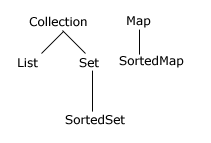|
Java collection framework tutorial - contributed by Pradip Patil
Collection
Collection Overview:
The java.util package contains all the classes and interfaces related to the
collection Framework. A collection represents a group of objects, known as its
elements.
All general-purpose Collection implementation classes .Collections are primarily
defined through a set of interfaces.
.
Collection interface: This enables you to work with group of
objects; it is at the top of the collections hierarchy.
List interface: This extends Collection and an instance of List
stores an ordered collection of elements
Set : This extends Collection to handle sets, which must
contain unique elements
SortedSet : This extends Set to handle sorted sets
Map : This maps unique keys to values.
SortedMap : This extends Map so that the keys are maintained in
ascending order.
The collection classes: Some of the collection classes are
following
| Class |
Description |
| AbstractList |
Extends AbstractCollection and implements most of the List interface |
| AbstractCollection |
Implements most of the Collection interface |
| LinkedList |
Implements a linked list by extending AbstractSequentialList. |
| ArrayList |
Implements a dynamic array by extending AbstractList. |
| HashSet |
Extends AbstractSet for use with a hash table. |
| TreeSet |
Implements a set stored in a tree. Extends AbstractSet. |
| HashMap |
Extends AbstractMap to use a hash table |
| TreeMap |
Extends AbstractMap to use a tree. |
| HashTable |
Hashtable was part of the original java.util and is a concrete implementation
of a Dictionary. |
| Stack |
Stack is a subclass of Vector that implements a standard last-in, first-out
stack. |
| Vector |
This implements a dynamic array. It is similar to ArrayList, but with some
differences. |
Iterator Interface: for Select each element in a collection
Eg.
import java.io.*;
import java.util.*;
class Student
{
public
static void main(String args[])throws IOException
{
Hashtable hs=new Hashtable();
BufferedReader br=new BufferedReader(new InputStreamReader(System.in));
System.out.println("Enter how many no of students:");
int
n=Integer.parseInt(br.readLine());
for(int i=0;i<n;i++)
{
System.out.println("Enter Name:");
String name=br.readLine();
System.out.println("Enter Percentage:");
float per=Float.parseFloat(br.readLine());
hs.put(name,per);
}
Enumeration keys=hs.keys();
Enumeration values=hs.elements();
System.out.println("Details of Student:");
while(keys.hasMoreElements())
{
System.out.println("Name:"+keys.nextElement());
System.out.println("Percentage:"+values.nextElement());
}
System.out.println("Enter name of student to be serched:");
String name1=br.readLine();
keys=hs.keys();
values=hs.elements();
while(keys.hasMoreElements())
{
String str=(String)keys.nextElement();
if(str.equals(name1))
{
System.out.println("Percentage of "+name1+" is:"+hs.get(name1));
}
}
}
}
|